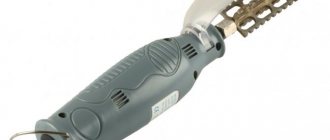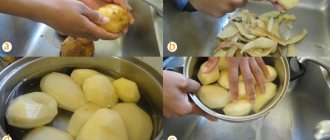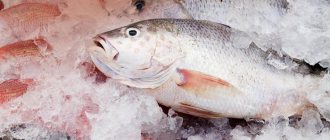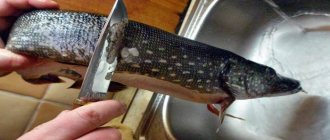The primary filleting of carp consists of cleaning the scales, gutting through a cut in the abdomen, and removing the vertebral and rib bones. Full cutting involves removing the skin from the carp fillet. Gutting for stuffing large fish can be done through a cut in the back to the abdominal cavity. Below are methods for cleaning scales, gutting, cutting large and medium-sized carp to obtain fillet steaks without skin and bones. After the initial stages of cutting, the carp can be baked whole and stuffed. Fillets in the form of steaks are more often used to prepare fried fish.
Preparing fresh fish
Carp lives in fresh water bodies; most often this fish ends up on the table from a store or as a fisherman’s catch. If it was caught with bait, then the latter needs to be removed from the throat; this can be done by directing a stream of water there, which will wash away all the excess. You also need to remove the gills from the head, where bacteria begin to multiply first. All this is necessary if the preparation requires the presence of a head, otherwise it can simply be cut off later.
The carcass must be thoroughly washed to remove silt and the slimy coating that protects the scales. To do this, simply rinse the carp under running water. It is also worth cutting off the fins first so that they do not interfere when the time comes to clean the carp from scales. They can easily hurt you.
Removing scales
At this stage, it is most difficult to clean carp, so you must know how to properly remove scales from the fish. It is best to use a special fish cleaning device for this. They have sharp serrations that easily separate even the toughest scales. Such devices are sold in stores or can be made independently.
During cleaning, the scales fly in different directions. To avoid this, housewives recommend cleaning in a basin of water so that the scales remain in it. Either place the fish inside the bag and put your hands in there to clean it inside, so all the cleaning will remain there.
Advice! To more easily and effortlessly separate the scales from the fish, it must be placed in boiling water. The time required to achieve the desired effect is no more than 1 minute, otherwise the carp will be cooked.
Scales from large fresh carp can be removed with a knife. To do this, place the fish on a cutting board and, pressing down on the tail, clean the carcass with sharp movements. But it is in this case that the housewife finds herself in a situation where, after she has cleaned the carp, she needs to clean out the kitchen. Therefore, the above measures should be taken.
Features and value of carp
Carp is an artificially bred species of fish, the ancestor of which is the carp. The word "carp" comes from the Greek language and is translated as fruit. And for good reason: one female produces up to 1.5 million eggs. The Chinese were the first to breed domesticated carp. Historians believe that this fish began to be used as food back in 1000 BC. e. Carp dishes became a favorite treat for Chinese emperors. Later, fish began to be bred in other Asian countries and Europe.
Carp meat has great benefits for the body. It is very tender and sweetish in taste. The fat content of fish muscle tissue is lower than that of lean beef, which is important for people on a low-fat diet, as well as for children and athletes. Carp is a source of many important nutrients, proteins and omega-3 fatty acids. These unsaturated acids have a positive effect on cardiac function and help prevent cardiovascular diseases. Another feature of carp is its ease of digestibility, due to the special structure of muscle fibers.
It takes three or four years to grow carp in artificial reservoirs. Three-year-old individuals reach a weight of about 2 kg, and four-year-old individuals weigh more than 2.5 kg.
Carp is a domesticated form of carp
Carp is a large and healthy fish
Carp meat is very healthy, as it contains many different minerals, vitamins and other substances necessary for the normal functioning of the human body. The presence of iodine in meat improves blood composition, normalizes metabolism, and prevents endocrine disorders. The high phosphorus content has a beneficial effect on the functioning of brain cells. The meat of this fish contains antioxidants that preserve our youth and protect the body's cells from the negative effects of free radicals. Eating carp is recommended for people watching their weight - the meat is well absorbed by the body and satiates without extra calories.
Cleaning and cutting of carp
Currently, a huge number of recipes for cooking carp have been invented. It is baked with a side dish of vegetables, potatoes and cereals, and also boiled with spices, stuffed in various ways and simply fried in vegetable oil until crispy. On store shelves you can find gutted frozen fish, fillets and ready-made semi-finished products. But you'll get the most benefit from fresh or live carp. Don't be afraid of the upcoming hassle with cutting the fish. Having mastered a few simple rules, you can easily turn live carp into a culinary masterpiece.
The most common carp on sale are common and mirror carp. The latter is a little easier to clean, due to the fact that its scales are large and not very tightly pressed to each other. With common carp you will have to tinker a little longer.
What you need for work
To properly and easily clean and cut fish you will need the following tools:
You also need to prepare:
Step-by-step instructions for cleaning, gutting and cutting carp
Some housewives clean and cut fish in the sink
To prevent the fish from slipping out of your hands, wear work gloves
Remove scales using a scraper
Cut the carcass along the belly and remove the entrails
Remove the head or take out the gills
How to skin a whole carp - gallery
How to fillet fish
When cutting carp into fillets, you need to separate the meat from its inedible parts: skin, spine, bones. To do this, it is not necessary to first gut and scale the fish.
To fillet carp, you need to make an incision along the gills of the fish.
An incision is made from the side of the dorsal fin before the incision along the gills
In the tail part of the carp carcass you need to cut through it with a knife
When separating the meat, the ribs do not need to be cut off: they should remain on the backbone
You need to remove the fillet first from one side, then from the other.
Make a cut in the middle of the fish up to the skin to remove it
After separating the carp meat from the bones, you need to remove the skin.
The art of cutting carp - video
Now you can easily diversify your family’s diet with carp dishes. The described instructions will help you quickly and correctly clean and cut fish that is very tasty and rich in nutrients.
Source
Filleting
To get a high-quality boneless fillet, you can do the following steps, which in their sequence are slightly different from those presented above:
- Remove scales, rinse, removing mucus from skin.
- Gut the fish.
- Remove gills. Leave the head to make it easier to hold the carcass during cutting.
- Place the carp's head to the left. Using a knife, carefully make a slit from the gill cover, reaching the spinal bone, but without cutting through it. Then turn the knife in a horizontal plane and begin to move, sliding along the spine.
- Remove the knife blade from the caudal fin, leaving it on the side of the spinal bone.
- Turn the fish over, leaving the head on the left and repeat the same with the other barrel.
If you need to get fillet without skin, then the skin can be removed from the whole fish carcass. To do this, first make a small cut on the skin from the tail. Pry it off with the sharp side of the blade. And taking the edge with your fingers, begin to remove the skin with a stocking.
If you can’t do this with the whole fish at once or you don’t have enough experience in gutting, then it’s better to simultaneously run the sharp tip of a knife along the entire back, cutting the muscle fibers into 2 parts. Remove the skin from each part separately.
Such fillets, both with and without skin, can be fried in a frying pan, baked in the oven or on the grill. If you gut the fish correctly, you can cook it into a transparent fish soup that has excellent taste.
How to cut carp for frying
Cutting a fish is a real art. Everything unnecessary must be removed. In this case, you must not damage the skin of the fish so that it does not fall apart in the pan and looks beautiful on the plate. How to fillet fish correctly?
Gut the carcass in advance, remove the scales, remove the gills. Then start filleting the carp.
Use scissors to cut off all the fins of the fish. Try to cut the fins so that the root of the fin remains. This is necessary so as not to cut through the fish skin or damage the integrity of the future fillet.
Cut off the carp's head diagonally, as if in a circle, so that less flesh remains on the head.
Start with the abdomen. Cut through the carcass to the spine, then turn the fish over and cut through the flesh from the other side to the spine. Hit the back of the knife blade several times with your palm, it will cut the spine and separate the head of the carp.
Cut off the fish tail.
How to remove bones when cutting?
Without removing the first fillet, make a cut on the other side of the spine, deepening the cut, cutting through the small bones.
Turn the carcass, place the blade flat on the side of the head. Raising the fillet slightly, cut the first rib bone with a knife. When chopping thick rib bones, run the knife along the entire length of the fish. Cut the second fillet in the same way.
Set aside the ridge. The fins, the ridge, the head will go to the ear.
Set aside the rib portion. There are many small seeds in it, running in three rows. It is best to pass two rib parts through a meat grinder three times. The bones will remain inside the meat grinder, and you will get excellent minced fish.
There are many small bones in the tail section. Therefore, cut off the tail and make several crosswise notches on it. It is good to fry this piece in a large amount of oil so that the bones become crispy.
A piece of fillet from the costal line to the belly contains practically no bones, it is ideal for frying or baking. This is how you can effectively cut up carp for frying.
If you don’t have time to carefully fillet the fish, make notches on the fish, then fry the carp.
Source
How to remove skin
The cutting process begins with washing the fish under running water. At the second stage, it is necessary to remove the scales, moving the knife while cleaning against the growth of the bone plates.
Then, in order to cook high-quality fish, it is important to gut it correctly. We remove not only the entrails, but also the gills. Especially if the fish will be cooked with the head in the future. It is in the gills that not only pathogenic flora can accumulate, but also all the dirt filtered from the water. Therefore, if this part of the fish is not removed before cooking, the finished dish may taste bitter or acquire another unpleasant and unnatural taste.
Once the gutting process has been completed and the head has been properly cleaned or cut off, it is worth removing the skin from the fish if you plan to fillet it.
This process is easiest to implement if you immediately cut and separate from the bones using the following steps:
- If the head of the fish is cut off, insert the knife between the ridge and the muscle fibers on the cut side. Hold the carcass with its head to the left and its tail to the right.
- Carefully, arching the blade, run the knife along the entire spinal bone from head to tail. Try not to damage the integrity of the muscle structures that lie in the thickness of the carcass.
- Remove the cut fillet that currently remains on the skin.
- Turn the fish carcass over with the other side up. Do the same manipulation, now moving the knife by the ridge, which will lie on the board.
- The result of these actions is 2 whole pieces of fillet on the skin.
If the recipe allows it, you can fry or bake the carp on the skin. But, if you want to get rid of the fish skin, then you should remove it. To do this, we cut the carp further. Place the fillet on the skin now with the tail part to the left. We carefully place the knife between the muscle structure and the skin. The knife can be held in one place, and the skin can be pulled to the side with your left hand. It is necessary to ensure that the carp muscles remain intact, otherwise the integrity of the fillet will be compromised.
Do the same with the second half of the cut fish.
Carp cutting
1. So, running a fish knife horizontally along the dorsal fin, carefully separate the upper half of the fish from the ridge and turn the fish into a butterfly.
Using a fish knife, cut the fish horizontally along the dorsal fin
2. Lifting by the tail, separate the entire ridge along with the ribs. This way you will remove all large bones. The back of the carp - the part that is located above the midline, also has its own midline, separating two longitudinal muscle groups. It is along this line that these thymus bones are located, supporting the uppermost group. If you now run the knife vertically along the back, approximately in the middle, you will be able to push these two muscle groups apart and the bones will stick out in the middle.
Divide the back fillet approximately down the middle so that the bones can be removed.
3. The bones can be decisively and quickly removed with fish tongs or tweezers, they will be clearly visible. After this, you can eat the carp without spitting and without fear. Try it, it's not as difficult as it might seem.
Bones are best removed with tweezers.
Cooking carp
1. Scale and gut smaller fish,
Clean and gut the carp
2. Cut large fish into 2-3 cm slices and then gut them
Cut large fish into slices
3. Remove the fillet from the smaller one and chop it. Mix chopped fillet with white bread soaked in milk and fried onions, butter, raw eggs, beat well.
How to remove mucus from carp?
How to clear mucus
- Place the carcass in very hot water for 15–20 seconds. During this time, the mucus will disappear and you can begin cleaning.
- The second method is also quite simple. Before cleaning, rub the product with salt. ...
- When fishing, you can use sand instead of salt. ...
- For 3 l.
12 Dec.
2022 Interesting materials:
How to smoke hot smoked lard in a smokehouse? How did Korea split into North and South? How to feed a calf from the first days of life? How to paint your nails with regular polish? How to say goodbye beautifully? How to beautifully cut out a photo in Photoshop? How to rotate a building in Rast? How cool is it to spend a day alone? How is social phobia treated? How to easily remove the skin from red fish?
Baking carp
I really like to bake large mirror carps weighing 2 kilograms or more. This is the easiest method and one of the most delicious; the fish turns out to be as juicy and tender as possible.
1. A whole carp needs to be gutted without peeling the scales, rub the inside with salt, put a bunch of greens and a few slices of lemon in the belly, rub the outside with honey, paprika and olive oil.
Gut the carp, rub the belly with salt and add lemon slices
2. Cover a baking sheet with baking paper, place the carp and salt the scales on top. Preheat the oven to 180C with convection and place a baking sheet with carp in the middle of the height. Bake for approximately 30 minutes.
Bake the carp for about half an hour
3. Remove the finished carp from the oven and set aside on a baking sheet.
. cover with foil and let stand for 5-10 minutes.
Remove the finished carp from the oven, cover with foil and let stand for 10 minutes.
4. Serve carp with fresh or baked vegetables.
Serve cooked carp with vegetables
Carp in beer
1. The carp needs to be gutted.
Gut the carp before cooking
2. Next, clean the fish from scales (the sequence is exactly this - if you peel off the scales from an ungutted carp, there is a high risk of crushing the gall bladder and all is lost; in general, you should gut river fish carefully), you can leave it whole or immediately cut large fish into portions.
Remove scales from fish
3. Place a bed of chopped onions and roots on the bottom of the pan, place the carp on top, add ten grains of black and allspice, a bay leaf, pour in beer until just covered, and put on medium heat. Once boiling, reduce heat to low and simmer for about 10 minutes.
Place the carp on the bottom of the pan, pour in beer and put on fire
4. Then the pieces of carp or whole fish are transferred to a dish.
Place the carp on a plate
Prepare the sauce
5. Strain the finished sauce and pour it over the fish on a platter. Anyway, it's beautiful.
Pour the prepared sauce over the fish
Source











